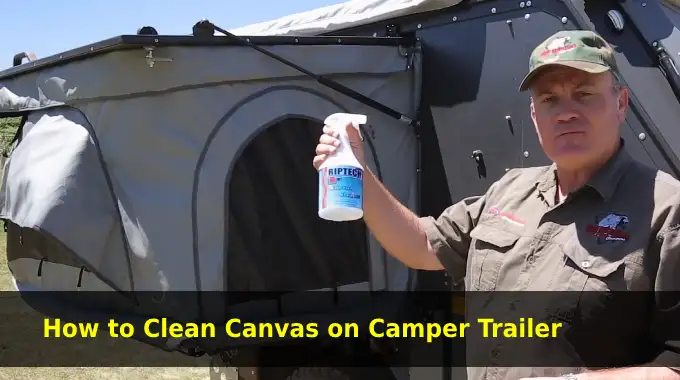Last Updated on April 29, 2023
If you’re an avid camper, you know that maintaining your trailer is just as important as hitting the open road. Canvas is one of the most common materials used to make camper trailer covers and awnings. While it’s a durable and reliable material, it does require occasional cleaning to keep it in top condition.
Now you may think about how to clean canvas on camper trailers and how difficult it may be.
Cleaning the canvas on your camper trailer may seem daunting, but it can be a breeze with the right tools and techniques. By determining the type of canvas, gathering your materials, and following some simple steps, you can restore your camper to its original state.
In the following article, we’ll provide step-by-step instructions on how to clean the canvas on your camper trailer so you can hit the road looking fresh and ready for anything.
How to Clean Canvas on Camper Trailer: DIY Steps
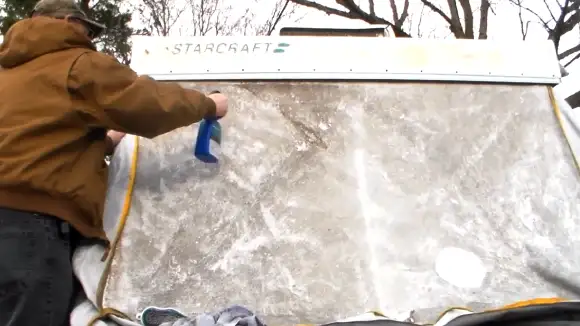
Here’s how to clean canvas on your camper trailer so that it looks as good as the day you bought it. To maintain your camper trailer in tip-top condition, let’s explore the detailed process of cleaning canvas.
Step 01: Gather Your Materials
To properly clean the canvas on your camper trailer, you will need to gather some materials beforehand. Having all of the necessary items ready before starting will make the cleaning process much smoother and more efficient.
Firstly, you will need a soft-bristled brush or a vacuum cleaner with an upholstery attachment to remove any loose dirt and debris from the canvas surface. This step is crucial as it will prevent dirt from being rubbed into the fabric during cleaning.
Next, you should have a bucket of warm water and a mild soap or specialized canvas cleaner. Choosing a cleaning solution specifically designed for canvas is important, as harsh chemicals can damage the fabric. Reading the label carefully before purchasing is recommended.
You will also need a scrub brush or sponge for spot-cleaning stains and mildew. For tougher stains, consider using a specialized stain remover.
Lastly, having clean towels or rags available for drying off the canvas after rinsing is essential to avoid leaving any water spots.
Step 02: Determine the Type of Canvas
As you clean the canvas of your camper trailer, one crucial step is determining the type of canvas you have. This will help you choose the right cleaning solution and ensure you don’t damage the material.
There are two main types of canvas used for camper trailers: cotton and synthetic. Cotton canvas is a natural material that is breathable and durable, but it requires more maintenance than synthetic canvas. On the other hand, the synthetic canvas is made from materials like polyester or nylon and is typically more resistant to water and mildew.
To determine the type of canvas on your camper trailer, look for a tag or label with this information. If there isn’t one, you can do a simple test to figure it out. Take a small piece of the material and burn it (safely!) with a lighter or match. Cotton burns slowly and leaves behind ash, while synthetic materials melt and harden.
Once you know what type of canvas you’re working with, you can choose an appropriate cleaning solution for that material. In the case of cotton canvas, you’ll want to use a gentle cleaner that won’t damage the fibers.
If you have a synthetic canvas, you may be able to use a stronger cleaner, but you should still avoid anything too harsh.
Step 03: Choose a Cleaning Solution
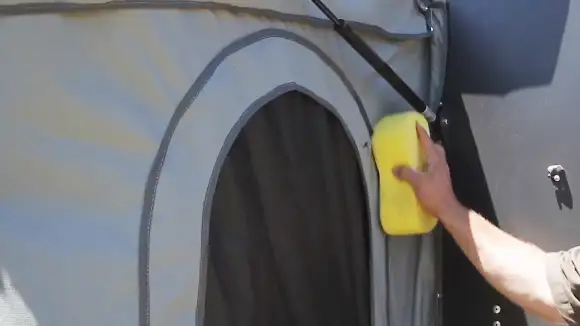
Choosing the right cleaning solution is crucial when cleaning the canvas on your camper trailer. You want to ensure you use a product that effectively removes dirt and stains without damaging the canvas material.
Several types of cleaning solutions are available for canvas, including specialized cleaners designed specifically for camping equipment. Before purchasing any cleaning solution, it is crucial to identify the type of canvas on your camper trailer. This will help you choose a safe and effective cleaner for your specific canvas material.
For example, if you have a cotton canvas, you should avoid using harsh chemicals or bleach-based cleaners as they can weaken the fabric fibers and cause discoloration. Instead, opt for a gentle soap-based cleaner specifically formulated for cotton canvas.
On the other hand, if you have a synthetic canvas such as polyester or nylon, you can use a stronger cleaner designed for outdoor gear. These cleaners are typically more powerful and can effectively remove tough stains and mildew without damaging the synthetic material.
When choosing a cleaning solution, read the label carefully and follow the manufacturer’s instructions. Some cleaners may need to be diluted with water before use, while others may require a specific application method, such as spraying or brushing.
Step 04: Cleaning the Canvas
Once you have determined the appropriate cleaning solution, apply it directly to the affected area and let it sit for several minutes before scrubbing gently with a soft-bristled brush. Be sure not to scrub excessively to prevent damaging the fibers.
Step 05: Start with a Thorough Brushing or Vacuuming
Using a soft-bristled brush or a vacuum attachment, gently sweep the surface of the canvas to remove any loose dirt or debris. Be sure to pay special attention to any crevices or folds where dirt and dust can accumulate.
If you’re using a brush, ensure it’s not too stiff as this can damage the canvas material. A soft-bristled brush is ideal for gently removing dirt and debris without causing any harm.
Vacuuming is also an effective way to remove loose dirt and debris from your camper trailer’s canvas. Use a handheld vacuum with a brush attachment for best results. This will allow you to easily reach all areas of the canvas without damaging it.
Step 06: Spot Cleaning Stains and Mildew
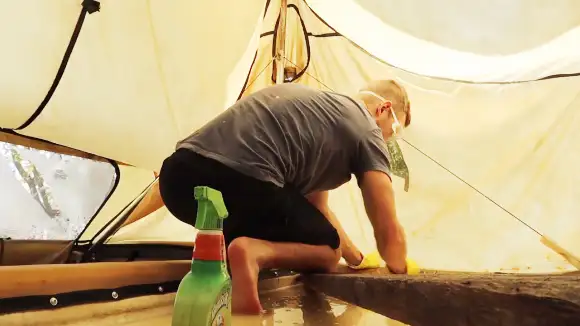
To start spot cleaning, use your soft-bristled brush or sponge to gently remove any loose dirt or debris from the affected area. Be careful not to scrub too hard as this can damage the fabric.
Next, mix your chosen cleaning solution with warm water according to the manufacturer’s instructions. Dip your brush or sponge into the solution and apply it directly to the stained area. Allow the solution to sit for several minutes (again following the manufacturer’s instructions) before gently scrubbing with your brush or sponge.
If you are dealing with mildew stains, using a stronger solution, such as white vinegar mixed with water, may be necessary. Apply this mixture directly to the affected area and allow it to sit for at least 15 minutes before scrubbing with your brush or sponge.
After scrubbing away any stains or mildew, rinse the area thoroughly with clean water until all soap residue is removed. Finally, allow the canvas to air dry completely before storing or using it again.
Step 07: Scrubbing the Canvas Surface
When it comes to scrubbing the canvas surface of your camper trailer, there are a few things you need to keep in mind. If you come across any stubborn stains that won’t come out with just gentle scrubbing, you can try using a specialized cleaner designed for canvas materials.
Just be sure to follow the instructions carefully and test it on a small, inconspicuous area first.
Step 08: Rinsing and Drying the Canvas
After scrubbing your camper trailer’s canvas surface, it’s time to rinse off the soap and residue. Make sure to use plenty of water to remove all traces of the cleaning solution from the canvas. Any remaining soap or residue could cause damage to the canvas over time.
When rinsing the canvas, using a gentle stream of water is important. High-pressure water can damage the fabric and cause it to weaken or tear. Use a garden hose with a spray nozzle attachment set on “shower” or “gentle” mode for best results.
Ensure you thoroughly rinse both sides of the canvas, especially if using a cleaning solution. No residue must be left behind as it can attract dirt and grime, leading to mold growth.
Once you have finished rinsing off all soap and residue, it’s time to dry the canvas. You should allow your camper trailer’s canvas to air dry completely before packing it away. Never put away wet canvas, as this will encourage mold growth.
To speed up drying time, you can use a fan or place your camper trailer in direct sunlight (if possible). But, be careful not to leave the canvas in direct sunlight for too long as this can cause fading and weakening of the fabric.
How To Maintain Your Clean Canvas On A Camper Trailer?
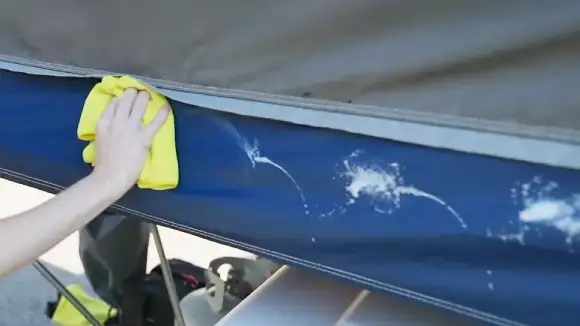
Now that you have successfully cleaned your camper trailer’s canvas, it is essential to maintain its cleanliness to ensure its longevity. Here are some tips on how to keep your canvas clean and protected:
Protecting Your Camper Trailer’s Canvas
To protect your camper trailer’s canvas, there are a few things you can do to increase its longevity and keep it looking new. The first step is to ensure the canvas is completely dry before storing it. Any moisture left on the canvas can lead to mold and mildew growth which can cause damage over time.
Another way to protect your canvas is by using a waterproofing spray. This will help repel water and prevent it from seeping into the fabric. Make sure to choose a spray that is specifically designed for canvas materials.
When setting up camp, try to park your camper trailer in a shaded area if possible. Direct sunlight can cause the canvas material to fade and weaken over time. If you don’t have access to shade, consider investing in a cover or tarp to provide extra protection.
Lastly, be mindful of any sharp objects that could come into contact with the canvas, such as tree branches or rocks. These can cause tears or punctures in the fabric, which can be costly to repair.
Regular Cleaning Schedule
To maintain a clean canvas on your camper trailer, it is essential to establish a regular cleaning schedule. This will ensure that your canvas remains in good condition and free from stains, mildew, and other debris.
The frequency of cleaning will depend on the amount of use and exposure to the elements. If you use your camper trailer frequently or live in an area with high humidity, you may need to clean the canvas more often.
A good rule of thumb is to clean the canvas at least once every six months. However, if you notice any stains or mildew growth, it’s best to clean it as soon as possible.
When establishing a regular cleaning schedule, consider the following factors:
- Frequency: Determine how often you need to clean the canvas based on usage and environmental conditions.
- Time of year: Plan your cleaning schedule around seasonal changes. For example, cleaning the canvas before storing it for the season is best if you live in an area with harsh winters.
- Type of cleaning: Decide whether you need to do a deep clean or spot cleaning based on the condition of the canvas.
- Cleaning products: Choose appropriate cleaning solutions that are safe for use on canvas materials.
Can you use a pressure washer to clean the canvas on your camper trailer?
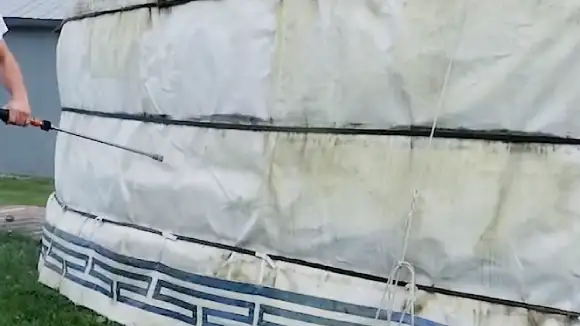
It is not advisable to clean your camper trailer canvas with a pressure washer. Pressure washers can cause permanent damage to the fabric, leaving it frayed or torn.
Also, pressure washing can cause leaks in the canvas, which can be costly. Instead, it is recommended to use a gentle brush or cloth with mild soap and water to scrub the canvas clean gently.
How should you store your camper trailer canvas after cleaning?
After cleaning your camper trailer canvas, it is crucial to ensure it is entirely dry before storing it. Any remaining moisture can cause mildew and mold growth, which damages the fabric and gives off an unpleasant odor.
To avoid this, roll or fold the canvas loosely to allow air to circulate, and store it in a cool and dry place such as a garage or a closet. You can also sprinkle baking soda on the canvas to absorb moisture and prevent musty odors. These precautions will help ensure your canvas lasts for many upcoming camping trips.
Keep Your Camper Trailer Canvas Clean and Pristine
It’s tough to clean the canvas on your camper trailer, but with the right preparation and materials, it’s easy. It’s important to determine the type of canvas you have and choose a cleaning solution accordingly to prevent damage.
Starting with a thorough brushing or vacuuming and spot cleaning stains and mildew will help prepare the canvas for scrubbing. Rinsing off the soap and residue is crucial before drying the canvas completely.
Maintaining a clean canvas involves protecting it from future damage and establishing a regular cleaning schedule. By following these steps, you can keep your camper trailer looking its most attractive for a long time.

